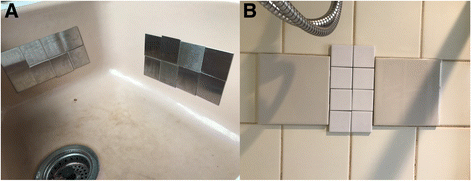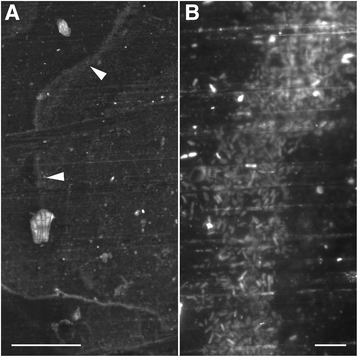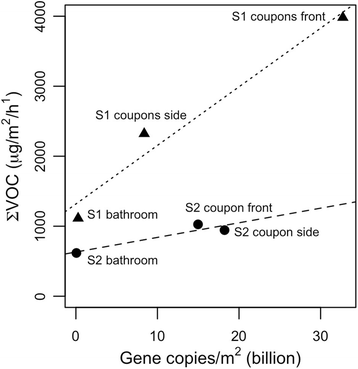Microbes and associated soluble and volatile chemicals on periodically wet household surfaces
- PMID: 28950891
- PMCID: PMC5615633
- DOI: 10.1186/s40168-017-0347-6
Microbes and associated soluble and volatile chemicals on periodically wet household surfaces
Abstract
Background: Microorganisms influence the chemical milieu of their environment, and chemical metabolites can affect ecological processes. In built environments, where people spend the majority of their time, very little is known about how surface-borne microorganisms influence the chemistry of the indoor spaces. Here, we applied multidisciplinary approaches to investigate aspects of chemical microbiology in a house.
Methods: We characterized the microbial and chemical composition of two common and frequently wet surfaces in a residential setting: kitchen sink and bathroom shower. Microbial communities were studied using culture-dependent and independent techniques, including targeting RNA for amplicon sequencing. Volatile and soluble chemicals from paired samples were analyzed using state-of-the-art techniques to explore the links between the observed microbiota and chemical exudates.
Results: Microbial analysis revealed a rich biological presence on the surfaces exposed in kitchen sinks and bathroom shower stalls. Microbial composition, matched for DNA and RNA targets, varied by surface type and sampling period. Bacteria were found to have an average of 25× more gene copies than fungi. Biomass estimates based on qPCR were well correlated with measured total volatile organic compound (VOC) emissions. Abundant VOCs included products associated with fatty acid production. Molecular networking revealed a diversity of surface-borne compounds that likely originate from microbes and from household products.
Conclusions: Microbes played a role in structuring the chemical profiles on and emitted from kitchen sinks and shower stalls. Microbial VOCs (mVOCs) were predominately associated with the processing of fatty acids. The mVOC composition may be more stable than that of microbial communities, which can show temporal and spatial variation in their responses to changing environmental conditions. The mVOC output from microbial metabolism on kitchen sinks and bathroom showers should be apparent through careful measurement, even against a broader background of VOCs in homes, some of which may originate from microbes in other locations within the home. A deeper understanding of the chemical interactions between microbes on household surfaces will require experimentation under relevant environmental conditions, with a finer temporal resolution, to build on the observational study results presented here.
Keywords: Bathroom tiles; Built environment; Chemical ecology; Emissions; Indoors; Metabolites; Microbiota; Stainless steel coupons; Volatile organic compounds.
Conflict of interest statement
Ethics approval and consent to participate
The study was approved by the University of California Committee for the Protection of Human Subjects under protocols 2015-02-7135 and 2016-04-8656.
Consent for publication
Not applicable.
Competing interests
The authors declare that they have no competing interests.
Publisher’s Note
Springer Nature remains neutral with regard to jurisdictional claims in published maps and institutional affiliations.
Figures







Similar articles
-
Microbiota formed on attached stainless steel coupons correlates with the natural biofilm of the sink surface in domestic kitchens.Can J Microbiol. 2016 Feb;62(2):148-60. doi: 10.1139/cjm-2015-0562. Epub 2015 Nov 13. Can J Microbiol. 2016. PMID: 26758935
-
Indoor microbiota in severely moisture damaged homes and the impact of interventions.Microbiome. 2017 Oct 13;5(1):138. doi: 10.1186/s40168-017-0356-5. Microbiome. 2017. PMID: 29029638 Free PMC article.
-
Pathogen suppression by microbial volatile organic compounds in soils.FEMS Microbiol Ecol. 2019 Aug 1;95(8):fiz105. doi: 10.1093/femsec/fiz105. FEMS Microbiol Ecol. 2019. PMID: 31265069 Review.
-
Microbial growth and volatile organic compound (VOC) emissions from carpet and drywall under elevated relative humidity conditions.Microbiome. 2021 Oct 19;9(1):209. doi: 10.1186/s40168-021-01158-y. Microbiome. 2021. PMID: 34666813 Free PMC article.
-
Bidirectional Interaction between Phyllospheric Microbiotas and Plant Volatile Emissions.Trends Plant Sci. 2016 Oct;21(10):854-860. doi: 10.1016/j.tplants.2016.06.005. Epub 2016 Jul 8. Trends Plant Sci. 2016. PMID: 27401253 Review.
Cited by
-
A different suite: The assemblage of distinct fungal communities in water-damaged units of a poorly-maintained public housing building.PLoS One. 2019 Mar 18;14(3):e0213355. doi: 10.1371/journal.pone.0213355. eCollection 2019. PLoS One. 2019. PMID: 30883565 Free PMC article.
-
RNA-based amplicon sequencing is ineffective in measuring metabolic activity in environmental microbial communities.Microbiome. 2023 Jun 13;11(1):131. doi: 10.1186/s40168-022-01449-y. Microbiome. 2023. PMID: 37312147 Free PMC article.
-
Reply to Sun et al., "Identifying Composition Novelty in Microbiome Studies: Improvement of Prediction Accuracy".mBio. 2019 Aug 6;10(4):e01234-19. doi: 10.1128/mBio.01234-19. mBio. 2019. PMID: 31387904 Free PMC article. No abstract available.
-
Microwave detection and quantification of water hidden in and on building materials: implications for healthy buildings and microbiome studies.BMC Infect Dis. 2019 Jan 18;19(1):67. doi: 10.1186/s12879-019-3720-1. BMC Infect Dis. 2019. PMID: 30658591 Free PMC article.
-
Daylight exposure modulates bacterial communities associated with household dust.Microbiome. 2018 Oct 18;6(1):175. doi: 10.1186/s40168-018-0559-4. Microbiome. 2018. PMID: 30333051 Free PMC article.
References
-
- Leff JW, Fierer N. Volatile organic compound (VOC) emissions from soil and litter samples. Soil Biol Biochem. 2008;40:1629–1636. doi: 10.1016/j.soilbio.2008.01.018. - DOI
-
- Bäck J, Aaltonen H, Hellén H, Kajos MK, Patokoski J, Taipale R, et al. Variable emissions of microbial volatile organic compounds (MVOCs) from root-associated fungi isolated from Scots pine. Atmos Environ. 2010;44:3651–3659. doi: 10.1016/j.atmosenv.2010.06.042. - DOI
-
- Kesselmeier J, Kuhn U, Wolf A, Andreae MO, Ciccioli P, Brancaleoni E, et al. Atmospheric volatile organic compounds (VOC) at a remote tropical forest site in central Amazonia. Atmos Environ. 2000;34:4063–4072. doi: 10.1016/S1352-2310(00)00186-2. - DOI
Publication types
MeSH terms
Substances
LinkOut - more resources
Full Text Sources
Other Literature Sources
Medical

